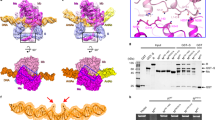Abstract
The antirestriction ArdB protein inhibits the endonuclease activity of type I restriction/modification (RM) systems in vivo; however, the mechanism of inhibition remains unknown. In this study, we showed that recombinant ArdB from Escherichia coli cells co-purified with DNA. When overexpressed in E. coli cells, a portion of ArdB protein formed insoluble DNA-free aggregates. Only native ArdB, but not the ArdBAD141 mutant lacking the antirestriction activity, co-purified with DNA upon anion-exchange and affinity chromatography or total DNA isolation from formaldehyde-treated cells. These observations confirm the hypothesis that ArdB blocks DNA translocation via the R subunits of the R2M2S complex of type I RM enzymes.
Similar content being viewed by others
Abbreviations
- GST:
-
glutathione S-transferase
- RM:
-
restriction/modification (system)
References
Belogurov, A. A., Delver, E. P., and Rodzevich, O. V. (1993) Plasmid pKM101 encodes two nonhomologous antirestriction proteins (ArdA and ArdB) whose expression is controlled by homologous regulatory sequences, J. Bacteriol., 175, 4843–4850, doi: https://doi.org/10.1128/jb.175.15.4843-4850.1993.
Serfiotis-Mitsa, D., Herbert, A. P., Roberts, G. A., Soares, D. C., White, J. H., Blakely, G. W., Uhrin, D., and Dryden, D. T. (2010) The structure of the KlcA and ArdB proteins reveals a novel fold and antirestriction activity against type I DNA restriction systems in vivo but not in vitro, Nucleic Acids Res., 38, 1723–1737, doi: https://doi.org/10.1093/nar/gkp1144
Kudryavtseva, A. A., Osetrova, M. S., Livinyuk, V. Ya., Manukhov, I. V., and Zavilgelsky, G. B. (2017) The C-terminal residue of aspartic acid (D141) is necessary of the antirestriction activity of protein ArdB (R64), Mol. Biol. (Moscow), 51, 831–835.
Balabanov, V. P., Kudryavtseva, A. A., Melkina, O. E., Pustovoit, K. S., Khrulnova, S. A., and Zavilgelsky, G. B. (2019) ArdB protective activity for unmodified X phage against EcoKI restriction decreases in UV-treated Escherichia coli, Curr. Microbiol., 76, 1374–1378, doi: https://doi.org/10.1007/s00284-019-01755-z
Pokrovsky, V. S., Anisimova, Yu. N., Davydov, Z. D., Bazhenov, S. V., Bulushova, N. V., Zavilgelsky, G. B., Kotova, V. Y., and Manukhov, I. V. (2019) Methionine gamma lyase from Clostridium sporogenes increases the anticancer effect of doxorubicin in A549 cells and human cancer xenografts, Invest. New Drugs, 37, 201–209, doi: https://doi.org/10.1007/s10637-018-0619-4.
Studier, F. W. (2005) Protein production by auto-induction in high density shaking cultures, Protein Expr. Purif., 41, 207–234, doi: https://doi.org/10.1016/j.pep.2005.01.016.
Sambrook, J., and Russell, D. W. (2001) Molecular Cloning: A Laboratory Manual, Cold Spring Harbor Laboratory Press, N. Y.
Goryanin, I. I., Kudryavtseva, A. A., Balabanov, V. P., Biryukova, V. S., Manukhov, I. V., and Zavilgelsky, G. B. (2018) Antirestriction activities of KlcA (RP4) and ArdB (R64) proteins, FEMS Microbiol. Lett., 365, doi: https://doi.org/10.1093/femsle/fny227
Guan, K. L., and Dixon, J. E. (1991) Eukaryotic proteins expressed in Escherichia coli: an improved thrombin cleavage and purification procedure of fusion protein with glutathione S-transferase, Anal. Biochem., 192, 262–267, doi: https://doi.org/10.1016/0003-2697(91)90534-z.
Solomon, M. J., and Varshavsky, A. (1985) Formaldehyde-mediated DNA—protein crosslinking: a probe for in vivo chromatin structures, Proc. Natl. Acad. Sci. USA, 82, 6470–6474, doi: https://doi.org/10.1073/pnas.82.19.6470.
Hoffman, E. A., Frey, B. L., Smith, L. M., and Auble, D. T. (2015) Formaldehyde crosslinking: a tool for the study of chromatin complexes, J. Biol. Chem., 290, 26404–26411, doi: https://doi.org/10.1074/jbc.R115.651679.
Han, M. J., Yoon, S. S., and Lee, S. Y. (2001) Proteomic analysis of metabolically engineered Escherichia coli producing poly(3-hydroxybutyrate), J. Bacteriol., 183, 301–308, doi: https://doi.org/10.1128/JB.183.1.301-308.2001.
Rosenfeld, J., Capdevielle, J., Guillemoi, J., and Ferrara, P. (1992) In-gel digestion of proteins for internal sequence analysis after one- or two-dimensional gel electrophoresis, Anal. Biochem., 203, 173–179, doi: https://doi.org/10.1016/0003-2697(92)90061-b.
Patterson, S. D., and Aebersold, R. (1995) Mass-spectrometric approaches for the identification of gel-separated proteins, Electrophoresis, 16, 1791–1814, doi: https://doi.org/10.1002/elps.11501601299.
Bazhenov, S. V., Khrulnova, S. A., Konopleva, M. N., and Manukhov, I. V. (2019) Seasonal changes in luminescent intestinal microflora of the fish inhabiting the Bering and Okhotsk seas, FEMS Microbiol. Lett., 366, pii: fnz040, doi: https://doi.org/10.1093/femsle/fnz040
Manukhov, I. V., Melkina, O. E., Goryanin, I. I., Baranova, A. V., and Zavilgelsky, G. B. (2010) The N-terminal domain of the Aliivibrio fischeri LuxR is a target of the GroEL chaperonin, J. Bacteriol., 192, 549–551, doi: https://doi.org/10.1128/JB.00754-10.
Bairoch, A., and Apweiler, R. (2000) The SWISS-PROT protein sequence database and its supplement TrEMBL in 2000, Nucleic Acids Res., 28, 45–48, doi: https://doi.org/10.1093/nar/28.1.45.
Zavilgelsky, G. B., Kotova, V. Yu., and Rastorguev, S. M. (2008) Comparative analysis of antirestriction activity of ArdA (ColIbP9) and Ocr (T7) proteins, Biochemistry (Moscow), 73, 1124–1130.
Balabanov, V. P., Pustovoit, K. S., and Zavilgelsky, G. B. (2012) Comparative analysis of antirestriction activity of R64 ArdA and ArdB proteins, Mol. Biol. (Moscow), 46, 269–275.
Author information
Authors and Affiliations
Corresponding author
Additional information
Russian Text © The Author(s), 2020, published in Biokhimiya, 2020, Vol. 85, No. 3, pp. 369–377.
Funding
The work was supported by the Russian Foundation for Basic Research (projects nos. 18-3400753 and 19-04-00495) and State Order no. 6.9899. 2017/BCh.
Conflict of interest
The authors declare no conflict of interest in financial or any other area.
Compliance with ethical standards
This article does not contain any studies involving animals or human participants performed by any of the authors.
Rights and permissions
About this article
Cite this article
Kudryavtseva, A.A., Okhrimenko, I.S., Didina, V.S. et al. Antirestriction Protein ArdB (R64) Interacts with DNA. Biochemistry Moscow 85, 318–325 (2020). https://doi.org/10.1134/S0006297920030074
Received:
Revised:
Accepted:
Published:
Issue Date:
DOI: https://doi.org/10.1134/S0006297920030074




